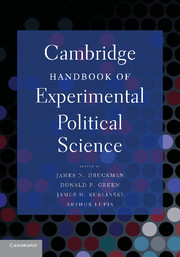Book contents
- Frontmatter
- Contents
- List of Tables
- List of Figures
- Contributors
- Acknowledgments
- INTRODUCTION
- PART I DESIGNING EXPERIMENTS
- PART II THE DEVELOPMENT OF EXPERIMENTS IN POLITICAL SCIENCE
- PART III DECISION MAKING
- PART IV VOTE CHOICE, CANDIDATE EVALUATIONS, AND TURNOUT
- PART V INTERPERSONAL RELATIONS
- PART VI IDENTITY, ETHNICITY, AND POLITICS
- PART VII INSTITUTIONS AND BEHAVIOR
- PART VIII ELITE BARGAINING
- 28 Coalition Experiments
- 29 Negotiation and Mediation
- 30 The Experiment and Foreign Policy Decision Making
- PART IX ADVANCED EXPERIMENTAL METHODS
- AFTERWORD
- Name Index
- Subject Index
- References
29 - Negotiation and Mediation
Published online by Cambridge University Press: 05 June 2012
- Frontmatter
- Contents
- List of Tables
- List of Figures
- Contributors
- Acknowledgments
- INTRODUCTION
- PART I DESIGNING EXPERIMENTS
- PART II THE DEVELOPMENT OF EXPERIMENTS IN POLITICAL SCIENCE
- PART III DECISION MAKING
- PART IV VOTE CHOICE, CANDIDATE EVALUATIONS, AND TURNOUT
- PART V INTERPERSONAL RELATIONS
- PART VI IDENTITY, ETHNICITY, AND POLITICS
- PART VII INSTITUTIONS AND BEHAVIOR
- PART VIII ELITE BARGAINING
- 28 Coalition Experiments
- 29 Negotiation and Mediation
- 30 The Experiment and Foreign Policy Decision Making
- PART IX ADVANCED EXPERIMENTAL METHODS
- AFTERWORD
- Name Index
- Subject Index
- References
Summary
Knowledge about negotiation and mediation comes primarily from laboratory experiments. The question asked in this chapter is what value is added by experiments for understanding processes of elite bargaining? This question is addressed in the following sections. After describing the international negotiation context, I provide a brief overview of the experimental approach. Then, key studies on distributive and integrative bargaining are reviewed, as well as examples of experiments that capture complexity without forfeiting the advantages of experimental control. The chapter concludes with a discussion of the value added by experiments.
The Context
Negotiating in the international context takes several forms. It occurs from a distance and face to face; deals with multiple complex issues; and includes bilateral, multilateral, and global participation. National leaders often make demands or exchange proposals from a distance. Well-known examples include the bilateral exchanges between the United States and the Soviet Union over the 1948–49 blockade of Berlin, between Kennedy and Khrushchev in 1962 over Soviet missile bases in Cuba, and between Carter and Khomeini concerning American hostages in Iran in 1979–80. Leaders and their representatives also confront each other face to face to discuss their interests over security, monetary and trade, or environmental issues.
- Type
- Chapter
- Information
- Cambridge Handbook of Experimental Political Science , pp. 413 - 429Publisher: Cambridge University PressPrint publication year: 2011
References
- 6
- Cited by



